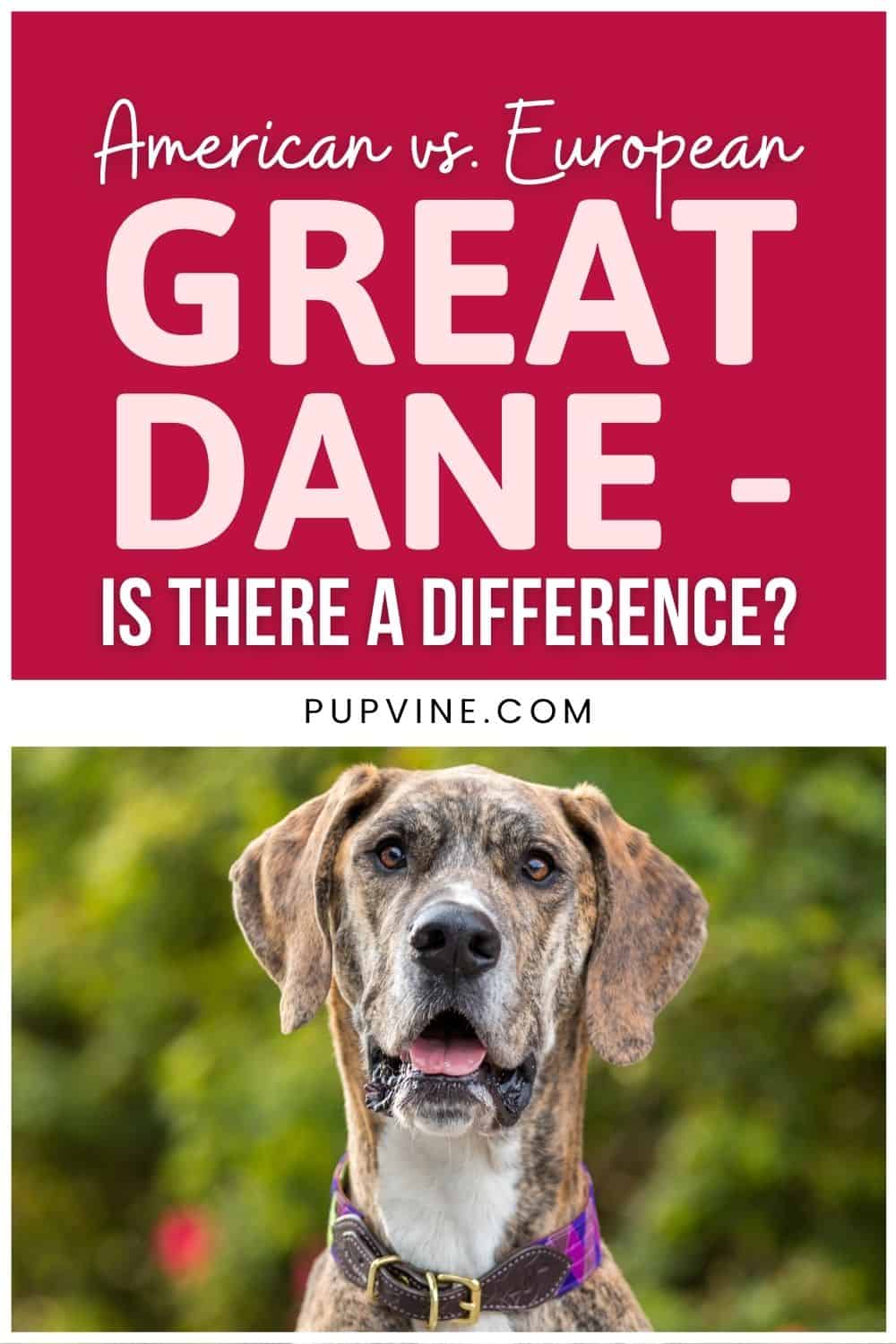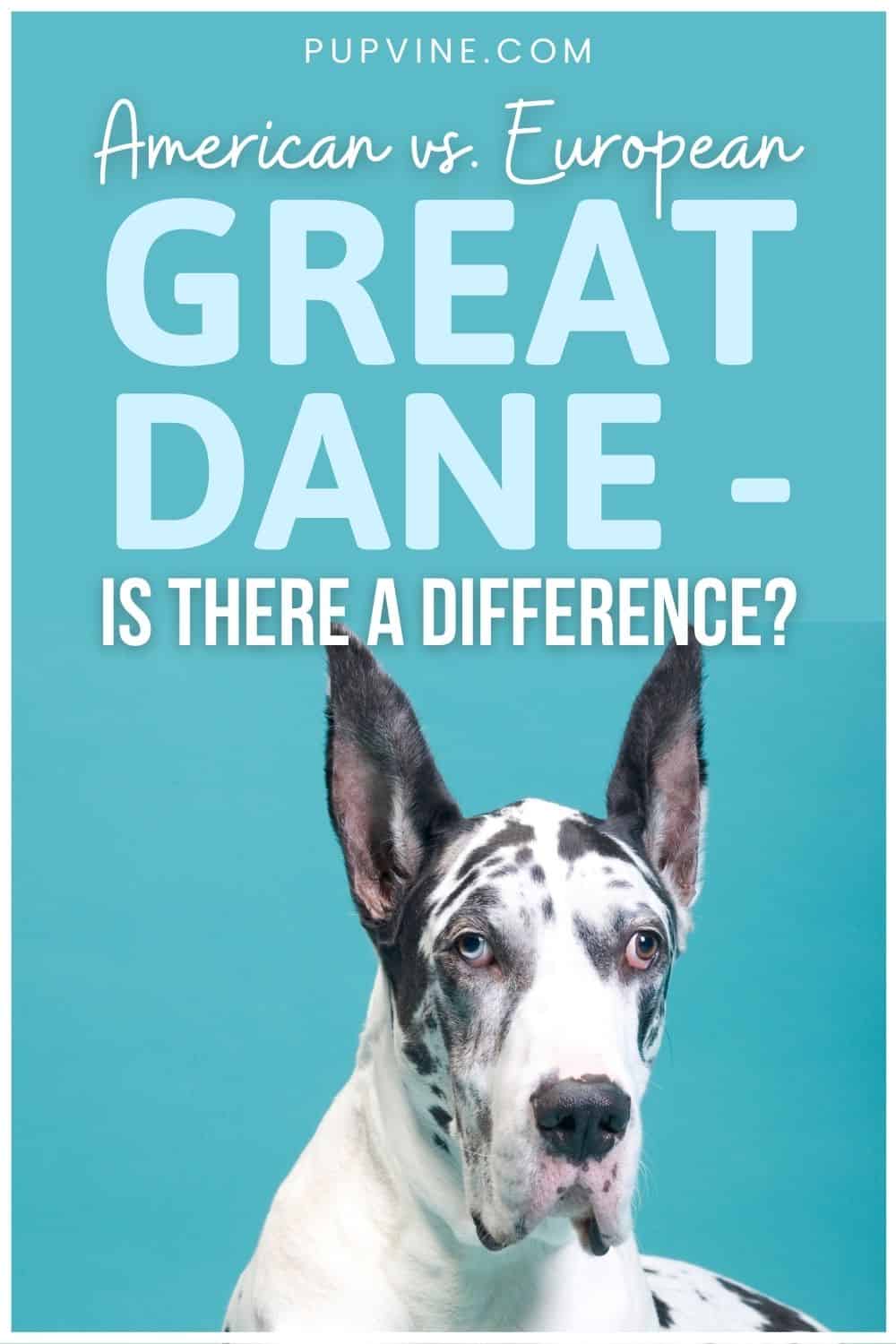We all know Great Danes as these huge German dogs. But, did you know that there are, in fact, two types of this dog breed?
When bred properly, there may seem like there aren’t many differences between American and European Danes. This is proven in the fact that the breed standard for both types is identical according to both the Federation Cynologique Internationale (FCI) and the American Kennel Club (AKC).
Still, some difference exists, most notable in their build and head shape, although it isn’t as prominent as in many other dog breeds that have separated varieties.
If learning more about the American vs. European Great Dane interests you, you’re in the right spot! Here’s what you need to know.
The Great Dane Breed

All dogs that are known as purebred now were a long time ago considered crossbreeds. They were made by combining various dog breeds to get certain physical and behavioral traits that are considered desirable.
In the case of the Great Dane Breed, this includes Mastiffs, for their large muscle mass, Greyhounds, for their speed, and Irish Wolfhounds, for their size. These three breeds combined have created the ‘base’ for the Great Dane breed.
These mighty dogs were initially used as hunting dogs. They were used in wild boar hunting! The Mastiff genes make them catch the prey and hold it until the hunter comes for it, while the Greyhound genes help it run fast.
There is a misconception that Great Danes originate from Denmark. However, this isn’t a Danish dog breed, but rather a German one. How Great Danes became associated with Denmark isn’t known, especially since the original name of the breed is Deutsche Dogs, or German dogs.
Initially, Germans bred two types of the Great Dane breed; one was quite slim in order to be able to climb the steep regions, while the other one was heavier for the plain areas.
In other words, the size and weight of Great Danes fluctuated depending on their surroundings. Just by knowing that, it’s easy to see how it came to the differences in American vs. European Great Danes.
Another factor that influences the dog breed’s appearance is the preference of judges in local dog shows. In Europe, heavier dogs seem to be prevalent and more appreciated, while the USA favors slimmer, much more elegant canines.
If we look at the breed standard, the most desirable dog stands somewhere between these two types, but it leans more towards the American Great Dane. However, that doesn’t mean that there is anything irregular with the European Great Dane breed.
Difference Between the European Great Dane and the American Great Dane
Here are some of the basic differences in the American vs. European Great Dane:
| European | American | |
|---|---|---|
| Height | 28 to 32 inches | 28 to 32 inches |
| Weight | 180 to 240 lbs | 125 to 135 lbs |
| Body type | Muscular, large | Sleek, elegant |
| Head shape | Heavy, square-shaped | Smaller, rectangular |
| Price | $1000 to $2000 | $600 to $3000 |
Why Are There Differences In American Vs. European Great Dane?
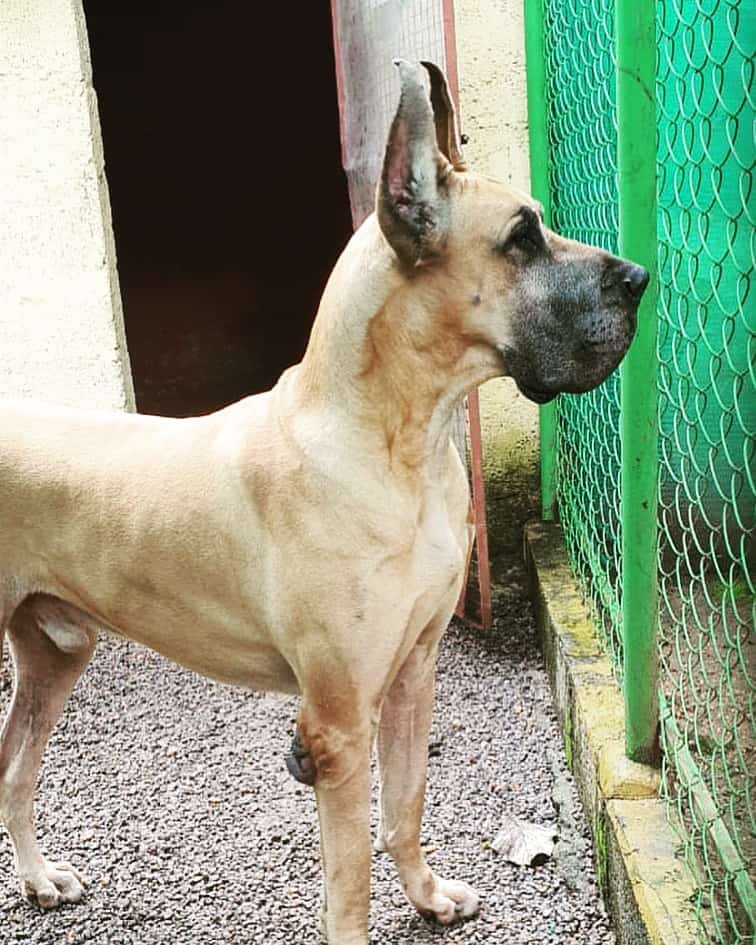
Photo from: @akris_cc
There are several reasons why there are variations in the Great Dane breed. In fact, a few entities stand behind this. Here’s what they are:
The Great Dane Breeders
Dog breeders are probably the main reason behind the two variations of the Great Dane breed. This actually makes a lot of sense.
Many breeders have purposefully altered the breed to adhere to the local public. People in different areas want different dogs, so breeders have done their best to give the buyers what they want.
Some breeders attempted to create a breed variation that is easier for them to take care of and to further reproduce, creating dogs that didn’t fit with the existing breed standard.
Overall, as the breeders are responsible for ‘creating’ the breed, it’s easy to see how they lead to the split within the breed as well.
Kennel Clubs
Kennel clubs are also responsible for different styles of dog breeds.
There are several kennel clubs that determine breed standards instead of just one. Some of them may offer different rules that certain breeders can follow. This can confuse both breeders and dog owners, as the same dog may look differently in different areas and still be up to the standard.
Dog Shows
Judges in dog shows often have their own preferences about how they want their dogs to look. Certain judges only vote for dogs that look the way they want them to look and behave.
Many people love buying dogs that look similar to winners of dog shows, even if they don’t plan to participate in shows themselves. This is how dog shows can greatly increase the popularity of a certain feature in a dog breed.
Dog Owners
Dog owners can be after a certain feature that isn’t entirely standard for the breed. If the demand is rising, breeders will do all they can to provide the supply, creating dogs that people like. Over time, this can lead to a change in the breed’s appearance and temperament.
The Government
Believe it or not, the government plays a role in the breed standards and behavior.
While rare, they may forbid or allow a certain trait, forcing breeders to change their breeding practices. On the other hand, the laws aren’t that strict about forcing people to stick to a certain breed standard, so the breeders are allowed to make some alterations.
American Vs. European Great Dane Appearance

As mentioned before, there are only minimal differences in appearance concerning American vs. European Great Danes. At first glance, you might think that these dogs look the same.
However, after more thorough observation, you may notice that these differences are much more obvious than you first thought.
To understand this, we’ll go over the appearance of both of these Great Dane breeds.
European Great Dane Dogs
The European Great Dane has many traits of a Mastiff dog. In fact, some dog lovers might confuse the two dog breeds as they are so similar!
European Danes are usually the taller of the two Great Dane breeds, although both are more or less the same height. However, the big difference comes in their weight. These dogs are huge! While most European Great Danes weigh around 180 lbs, some might be as heavy as 240 lbs. This is more than many humans weigh!
These large dogs have a square-shaped head that is rather heavy. However, if you look at the entire body and head ratio, you might think their head is somewhat short. Also, they have really droopy eyes and big, hanging lips. This also means they’ll likely drool a lot.
Just like the rest of their body, their neck is also thick and strong. This is another reason why their body might look stubby and muscular.
American Great Dane Dogs
Unlike their European counterpart, American Great Danes have more characteristics of a Greyhound – although it’s difficult to misplace these two dog breeds.
These Danes have sleek, elegant bodies and they aren’t as heavy or as muscular as European Great Danes. They’ll rarely weigh more than 135 lbs, making them quite lighter than European ones.
At the same time, they have fairly smaller heads that are more rectangular in shape, and streaked. While their lips will be somewhat hanging, this feature isn’t too extreme. This makes them look a bit more regal compared to the European variant.
Also, thanks to their body shape, they may seem lighter on their feet, and they’ll usually run faster. Overall, their entire appearance looks a lot more adjusted to conformation shows than to hunting.
American Vs. European Great Dane Coat Color
Coat color and type are something that isn’t really different in the two Great Dane breeds. These pups have a short and smooth coat that experiences a moderate amount of shedding. This means that these aren’t hypoallergenic dogs.
There are six accepted coat colors in both Great Danes, and these are:
• Black
• Blue
• Brindle
• Harlequin
• Fawn
• Mantle
While they can come in several other coat colors and patterns, such as chocolate or merle, only these six colors are accepted within conformation shows.
Fortunately, their short coats are fairly easy to take care of, as they only require brushing a few times a week. This will help you with the shedding, and it can bring you closer to your pooch.
Bathing them every few months is necessary, and as you can imagine, this isn’t an easy task. Fortunately, these are kind dogs that will usually respond well to any form of grooming, so you shouldn’t have too much trouble with them.
American Vs. European Great Dane Temperament
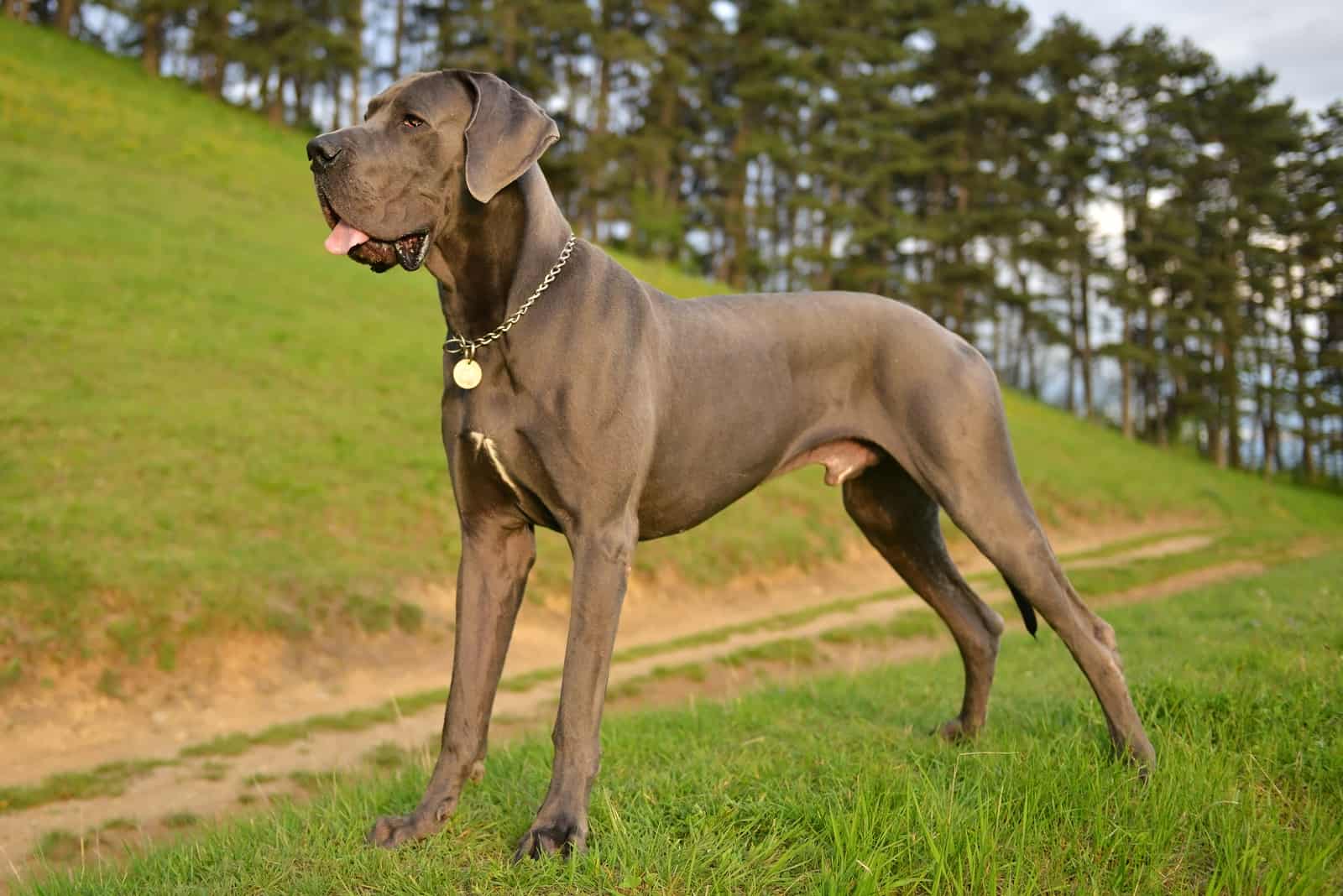
Great Danes are known as gentle giants. These are big dogs with an even bigger heart. They are very goofy and playful, but they know when to be serious.
However, just like with appearance, there are some minor differences in temperament that come with different breeding practices. Here’s what they are:
European Great Dane
European Great Danes were bred to be working dogs. They are more commonly bred for hunting or to be guard dogs, and not just as family pets. This is one of the things that shape their personality as well.
These dogs are affectionate, but love to have their comfort zone. They are docile and calmer than their American counterpart, but are still fairly active, with high energy levels.
American Great Dane
American Great Danes were trained to be house pets, so they are more cuddly than European Danes. They’ll love to sit on a couch with you, and some might even think they are lap dogs, despite their size!
Despite their friendliness, they can be wary of strangers, so they also make excellent guard dogs. Some would argue that their sleek bodies make them appear even more dangerous than European Danes.
However, it’s important to note that these dogs are very active, and they have huge energy levels. This can make them very hard to handle sometimes.
American Vs. European Great Dane Trainability
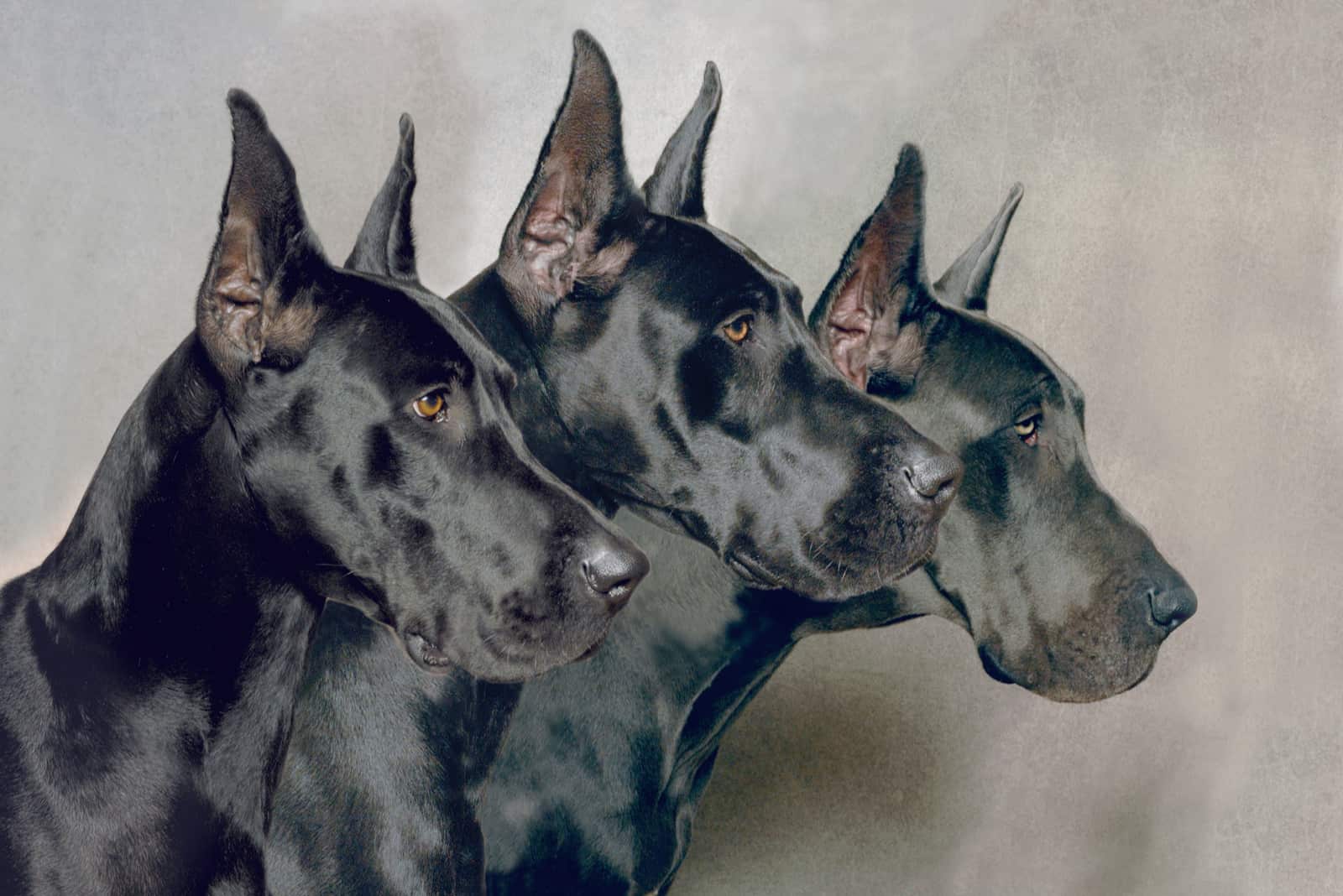
No matter the breed or the dog’s temperament, all canines require some level of training and socialization. While the exact amount varies depending on the individual dog, it’s important to know some guidelines for each breed.
When it comes to the American vs. the European Great Dane, which one is easier to train?
European Great Dane
European Great Danes are intelligent dogs that are fairly easy to train, but there is one catch: These dogs love consistency. They’ll only follow your command if they know you’re consistent and if you follow a certain schedule. If you break it, they’ll stop taking you seriously.
Another thing you have to keep in mind is that your verbal and non-verbal cues need to be consistent. European Great Danes are sensitive dogs that will carefully follow your body language, so if it isn’t in line with what you’re saying, they’ll get confused.
Still, if you manage to follow these two rules, your dogge will learn new tricks and commands in no time.
American Great Dane
American Great Danes are also intelligent, maybe even more than their European counterpart. At the same time, they are eager to please and they’ll do everything for their owners. All of this makes them very easy to train.
American Great Danes respond well to a consistent training method, but you need to stay strict. Don’t tolerate disobedience, but don’t punish them. Instead, use only positive reinforcement such as petting, praise, and treats.
Keep in mind that in some areas, it’s mandatory to take your American Great Dane to a professional dog trainer since they are very large and powerful dogs that can become dangerous if you don’t train them properly.
Which One Is Better With Strangers?

It’s open for discussion as to whether or not you should aim for a dog that is friendly with strangers. While most people want their Great Dane to be a great watchdog, you also want your friends and passersby to feel safe around your pooch.
Here’s what the difference is:
European Great Dane
European Great Danes aren’t that keen on meeting strangers. They are standoffish and they don’t like new people that much. It can take them a while to get used to a new person.
Because of this, you should socialize them from an early age. Otherwise, taking them on walks might be a bit stressful.
American Great Dane
American Great Danes are very social creatures. They’ll love to meet anyone! Despite their fierce looks, they’ll love to create new friends and playmates.
Still, as they are large and strong dogs, socialization is very important. Some dogs may deviate a bit from the standard breed behavior and they can be skeptical of strangers. Therefore, you have to do all you can to teach them how to behave in various social situations.
Which One Is Better With Other Pets?
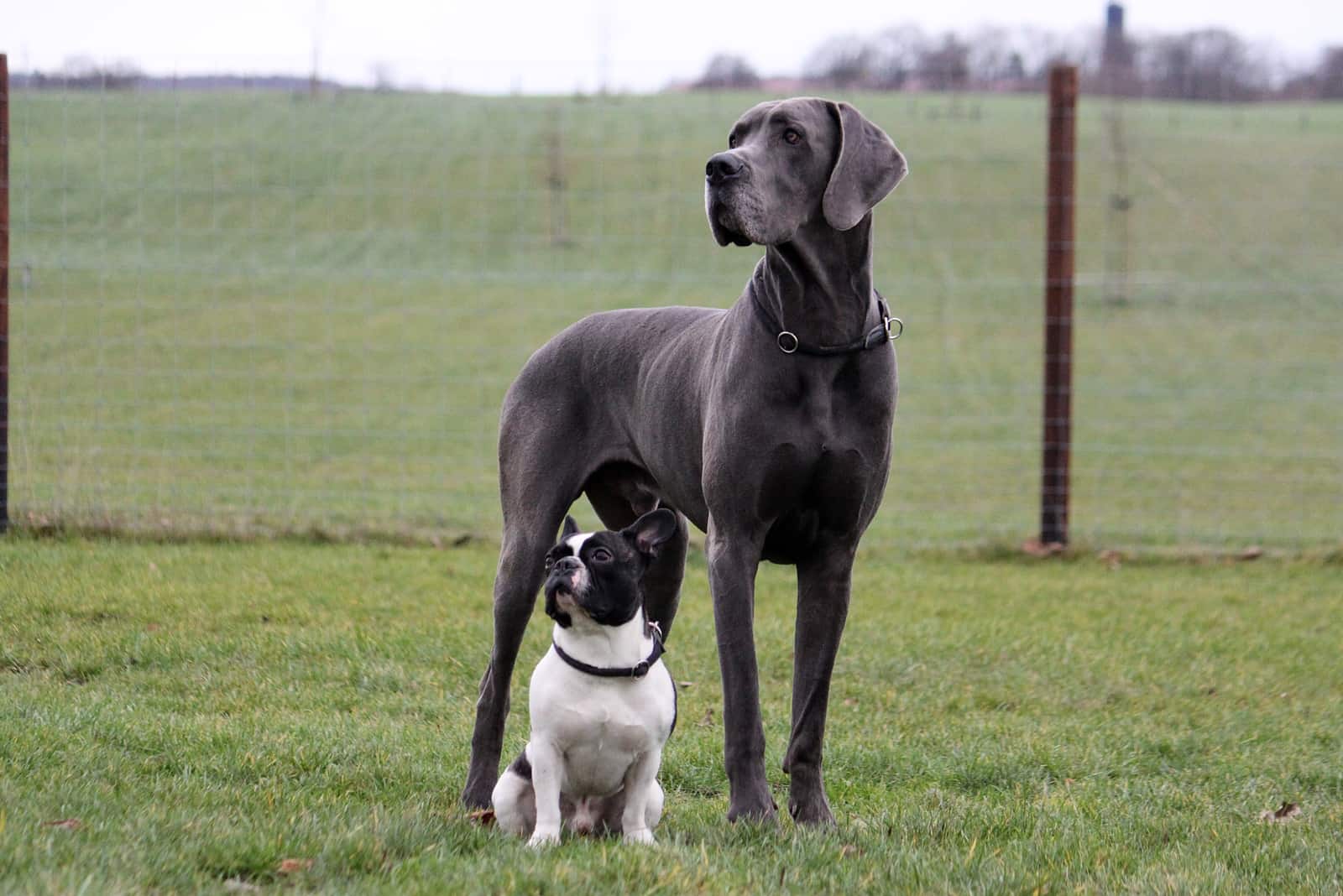
Even if you plan to keep your Great Dane as an only pet, you’d still want to know how they’ll behave around other dogs and pets.
Here’s what you need to know.
European Great Dane
Most of the time, European Great Danes will do excellent with other dogs. They are social animals that love to have as many playmates as possible.
However, some of these pups can be aggressive toward smaller prey animals. Also, don’t keep them together with a dog of the same gender. Due to their size, they can be hard to handle, so it’s always better to do all you can to prevent accidents from happening.
American Great Dane
These dogs are extremely gentle and kind. This means they’ll do very well with other dogs and pets.
Still, Great Danes were bred to be hunting dogs, and some of these hunting instincts remain to this day. This means they might show aggressive tendencies over smaller animals, as they’ll view them as prey.
Also, same-sex aggression can be a problem, so if you plan on getting another dog, always choose the one of the opposite gender.
Which One Is Better With Kids?

If you have small children, or if you plan on having kids or keeping your pet around kids, this is something that is very important to know.
Of course, children need to know how to behave around pets, including dogs. You have to teach them not to pull the dog’s ears and tail, or to touch their eyes, noses, mouths, or private parts.
Also, children shouldn’t shout around dogs. Canines have much greater hearing than humans, so they won’t do well in loud surroundings, which can stress them out.
Here is the difference between the American vs. European Great Dane and their compatibility with children:
European Great Dane
European Great Danes will love all household members, even kids. They are patient dogs that will tolerate children, even if they play a bit rough.
The biggest issue here is their large size, which can make it challenging for them to interact with kids. With just one wrong move, they might cause accidental injuries. This is why you should never leave them alone with children.
American Great Dane
American Great Danes also do great with children. They don’t mind a child’s active nature, and they’ll love to join the playtime.
However, they are very energetic dogs that can run around the whole day. This can make things a bit troublesome, as they might knock a child over while they jump or play. In other words, supervision is necessary.
Which One Is A Better Family Pet?

After reading the aforementioned information on the Great Dane’s personality, you might have your own conclusions about which one makes a better family pet.
Overall, American Great Danes are considered perfect family dogs. They aren’t aggressive, but at the same time, they aren’t timid, so they do great with kids. Also, despite their huge size, they are affectionate and dependable – some might even consider them a bit clingy!
While European Great Danes can be a bit shyer than their American counterpart, they, too, make amazing family pets. They are basically huge puppies that love to lay in their beds all the time!
As you can see, there isn’t really a huge difference. You cannot go wrong no matter which Dane breed you choose!
Which One Is a Better Guard Dog?
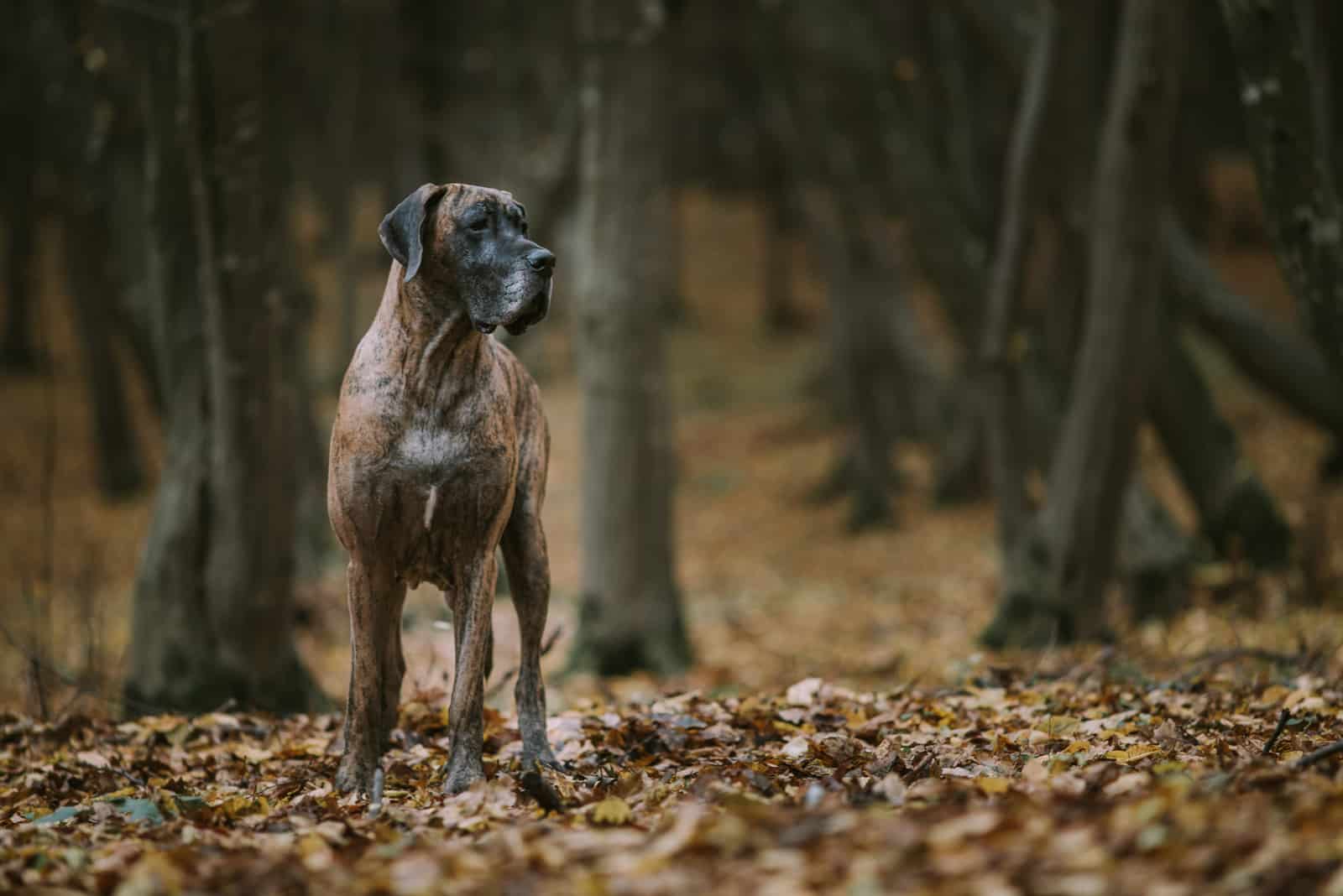
If you want to get a great guard dog that not a single intruder would want to mess around with, then a Great Dane sounds like the perfect choice. Still, is there a difference between the two breeds?
Despite them being bred to be working dogs, European Great Danes aren’t likely to attack anyone – intruders included. While they might not want everyone to pet them, they’re more likely to sleep when someone is trespassing than to react.
Similar to that, American Great Danes also aren’t likely to show aggression toward a stranger. They are even more friendly than European Danes, so they’re more likely to try to befriend everyone!
Fortunately, they love to bark, so they’ll probably alert you when something suspicious happens.
Luckily, both Great Dane breeds are huge in size, so they’re likely to scare off any burglars or people entering your property without authorization. Their fierce looks will make everyone want to run away!
American Vs. European Great Dane Movement

Photo from: @cedric_the_greatdane
There isn’t a noticeable difference in the way these two Great Dane breeds move. Still, believe it or not, the AKC and the FCI use different terms when they describe the movements of the Great Dane Breed.
If you want to visualize how these dogs move, then this information might interest you:
European Great Dane
The FCI describes the movement of the European Great Dane as lithe, harmonious, albeit a bit springy. They keep their legs parallel no matter if they walk or run. Also, their front and back legs are kept coordinated no matter what.
Since European Great Danes are a bit larger than American Great Danes, this means their stride covers more ground.
American Great Dane
These dogs have long, easy strides and a powerful gait. During movement, their topline doesn’t bounce, roll, or toss, and their backline stays parallel to the ground. Their head is kept forward, and when they run, their legs converge in the center, balancing their body.
American Vs. European Great Dane Ear Cropping
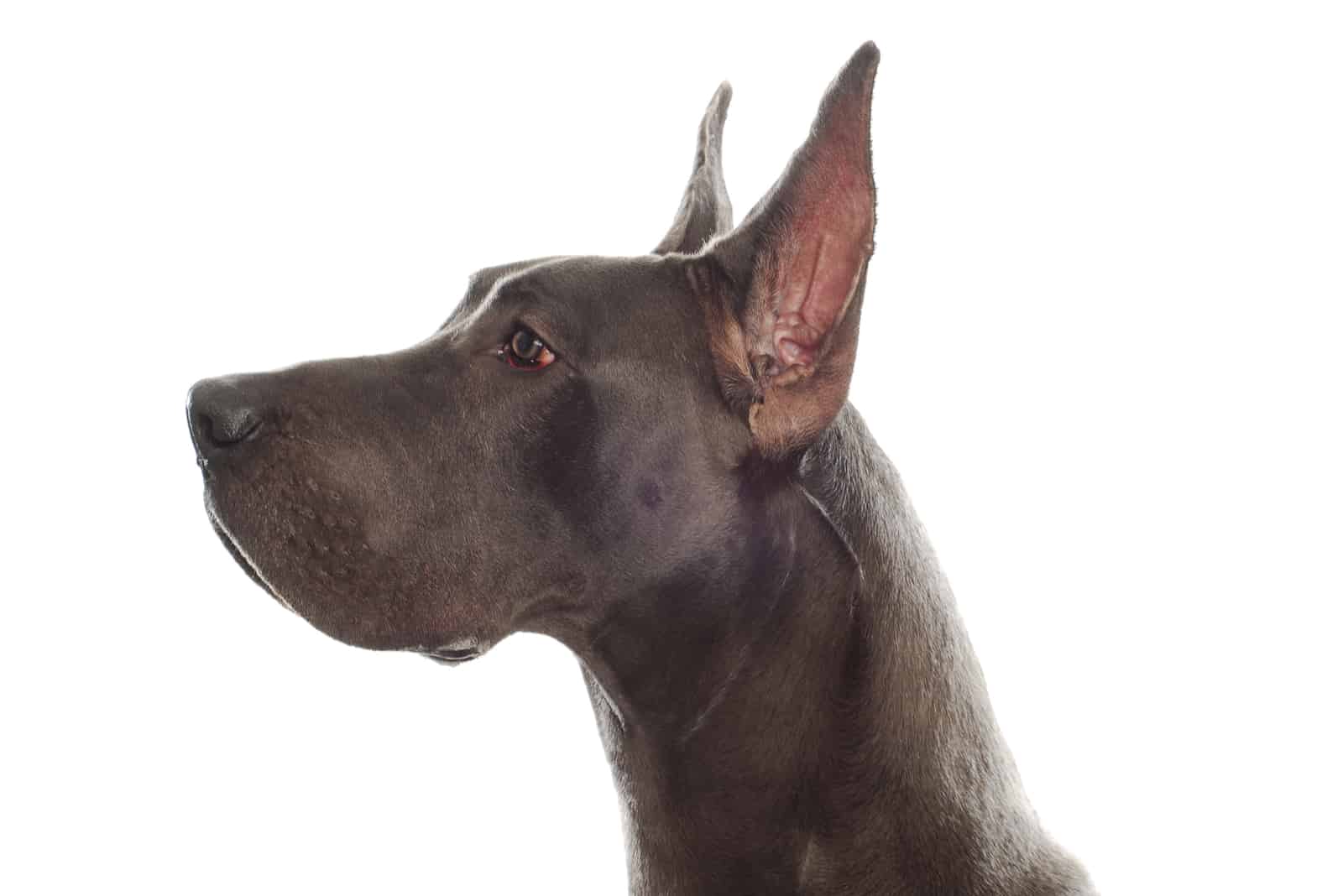
Ear cropping gives many dog breeds such as Pitbulls, Bulldogs, or Dobermans, the dangerous looks they are known for. This is why many people love having dogs with cropped ears.
However, ear cropping trends can vary greatly depending on the area you live in. In fact, this can be a huge indication of what Great Dane breed you’re dealing with!
European Great Danes
You’ll rarely see a Euro Dane with cropped ears. In fact, many European countries put a ban on canine ear cropping, so you cannot do this legally. Because of this, most European Great Danes have their natural, floppy ears.
Not just that, but many English, German, and Danish dog owners find the ear cropping practice extremely cruel, and they oppose it greatly. The same goes for most other European areas.
American Great Danes
Most American Great Danes will have cropped ears, as this process is almost considered a cult in the USA. Almost all Danes from this part of the world will have cropped ears, and even the Great Dane Club of America supports the practice.
In fact, if you plan to raise your American Great Dane to be a show dog, you should know that dogs with floppy ears might not be able to compete everywhere.
Which One Looks More Like the Breed Standard?
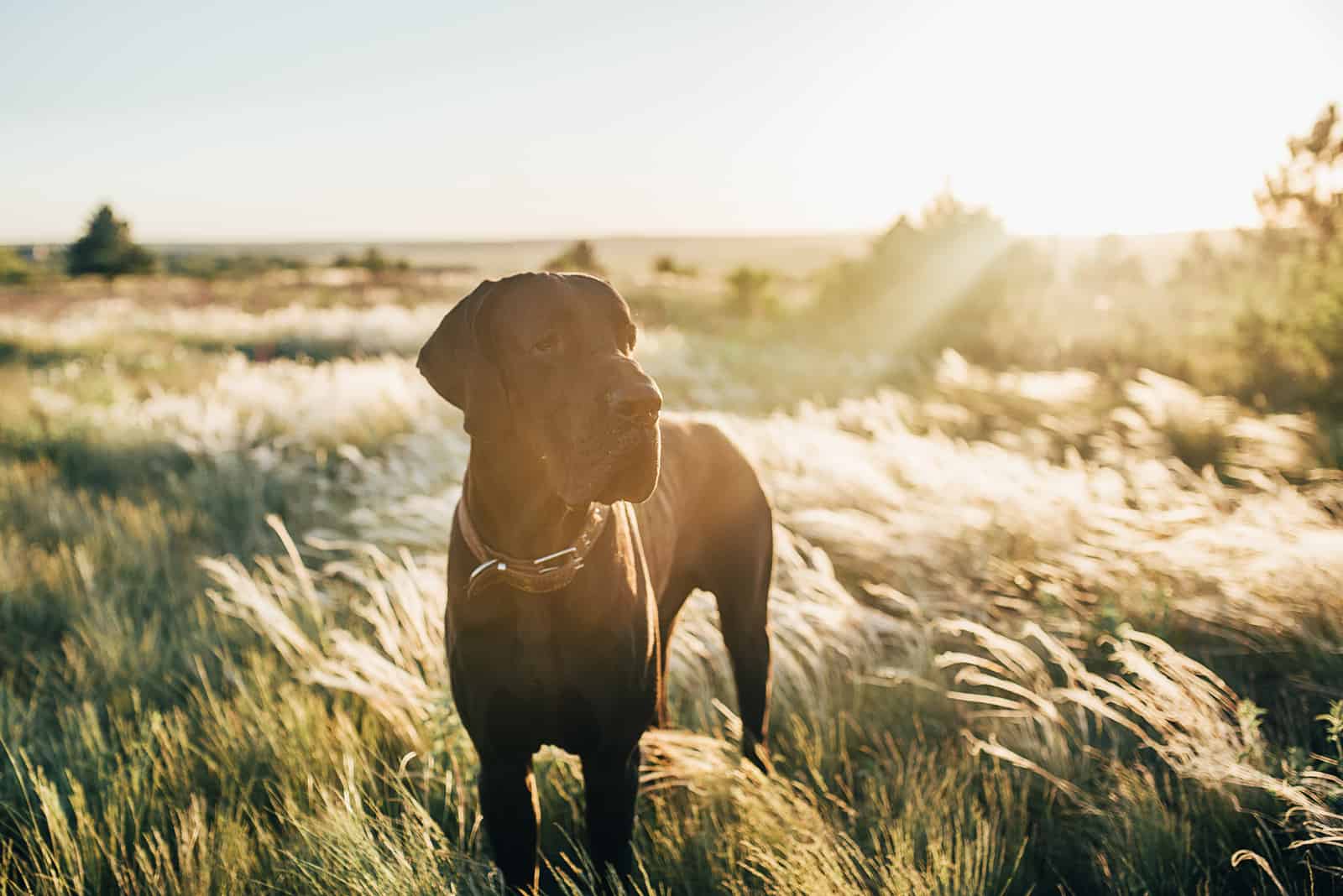
Believe it or not, neither the American nor the European Great Dane is following the breed standard set by both the AKC and the FCI! This is because these pups have changed greatly from the time when the standards were set.
To help you understand why this is so, we’ll compare both dog breeds to the standards they should follow, so you can see what the deviations are.
European Great Dane
European Great Danes have three noticeable traits that make them deviate from the breed standard.
First and foremost, they have droopy eyes, while the FCI states that Great Danes should have almond-shaped eyes. Any type of droopiness isn’t allowed. The same goes for excessive facial skin; something these dogs have a lot of.
Also, they have saggy lips despite the FCI stating that Great Danes should have straight lips and that sagging is undesirable.
Not just that, but if you take a closer look at the Great Danes across European countries, you might notice the creation of several other breed varieties.
For example, many countries prefer breeding hyper-type Great Danes that look a lot more like Mastiffs than the breed’s standard. In fact, some experts have started using the phrase ‘mastiffication’ or ‘mediterranisation’ to describe this process.
On the other hand, Nordic countries do their best to keep their dogs looking according to the breed standard, and they criticize both the classic European Great Dane and the new hyper-type.
American Great Danes
American Great Danes adhere to the AKC’s standard a bit more, although deviations exist here as well. Most notably, they, too, have somewhat droopy eyes, while the AKC also requires Danes’ eyes to be almond-shaped.
American Vs. European Great Dane Lifespan

Unfortunately, Great Danes, just like most other giant breeds, don’t have a long life expectancy. Overall, American Great Danes live 9 to 10 years, while European Great Danes live a bit shorter – up to 8 years.
This doesn’t mean that all dogs will live just that long. There have been instances where Great Danes have lived for more than 13 years! However, this isn’t common.
One of the reasons why they live so short is their great size. The larger the dog, the faster its cells divide during puppyhood, which, according to many scientists, is the reason why they are more susceptible to cancer and other diseases.
Another reason is that their organs need to carry that extra weight, so they shut off quicker.
Either way, both Great Dane Breeds are prone to the same diseases. While your Great Dane might live its entire life without contracting any of these health problems, it’s a good idea to be prepared so you can notice possible signs on time.
Here are some of the health issues Great Danes are prone to:
Gastric Torsion
Gastric torsion, also known as bloat, is the main cause of the Great Dane’s short lifespan. All bloodlines are susceptible to it, and you can never be certain that your dog won’t get it.
This is a common problem of all big dogs, and it occurs when the stomach twists, which prevents blood supply.
While bloat can occur without visible symptoms until it’s too late, some of the possible telltale signs include a swollen belly, a hunched standing position, lack of regular digestive noises, whining, pacing, shallow breathing, dry heaving, and a weak pulse.
Cardiomyopathy
Cardiomyopathy is an umbrella term that includes several diseases of the heart. Almost all of them cause the heart to enlarge.
Cardiomyopathy can pass without any symptoms until the dog suddenly dies. Because of this, you should always take your Great Dane to the vet if you notice him being lethargic, or having difficulty breathing.
Tricuspid Valve Disease
This is an inherited heart condition in which the left part of a dog’s heart fails. The usual signs of tricuspid valve disease are increased heartbeat and heart murmur.
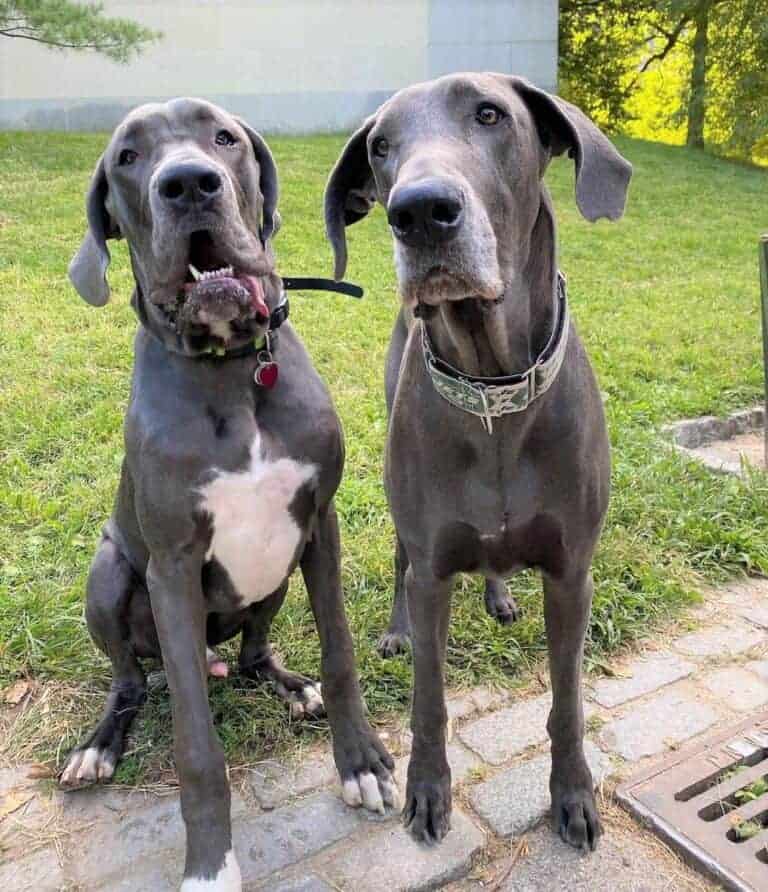
Photo from: @giantdoggo
Hypothyroidism
Hypothyroidism is the unusual production of thyroid hormones that is usually caused by autoimmune thyroiditis. Dogs suffering from hypothyroidism usually become obese, lose their fur, and become intolerant to cold weather.
Fortunately, hypothyroidism isn’t deadly, and it can be kept under control with proper medication and care.
Addison’s Disease
This is a disease common in middle-aged female Great Danes, and it occurs when the secretion of corticosteroids in the adrenal gland decreases.
While Addison’s Disease can ruin a Great Dane’s quality of life, it isn’t deadly when properly treated. This is usually done by replacing the mineralocorticoids and glucocorticoids in your furry friend’s body.
Wobbler Syndrome
This is a condition that affects the cervical spine and the neck of Great Danes. It’s also known as cervical spondylomyelopathy.
While not deadly on its own, Wobbler Syndrome can result in paralysis, which can be either partial or complete, and this can lead to further complications.
Hip Dysplasia
This is a progressive disease that usually affects Great Dane’s hind legs and it can severely decrease their quality of life. It leads to the failure of the femur bone, which can no longer fit the hip socket.
This disease can be treated with physical therapy, pain killers, weight reduction, or surgery. Luckily, you can lower the chances of your pup getting this by giving him proper dog food and ensuring that he gets enough exercise.
Read More: Great Dane Feeding Chart
Cruciate Ligament Tears
Cruciate ligament tears are common orthopedic conditions in many large dog breeds.
If you notice your Great Dane becoming lame in his hind legs, or if he experiences knee swelling, limping, or an awkward posture, chances are he has ruptured his cranial cruciate ligament.
European Vs. American Great Dane Puppies
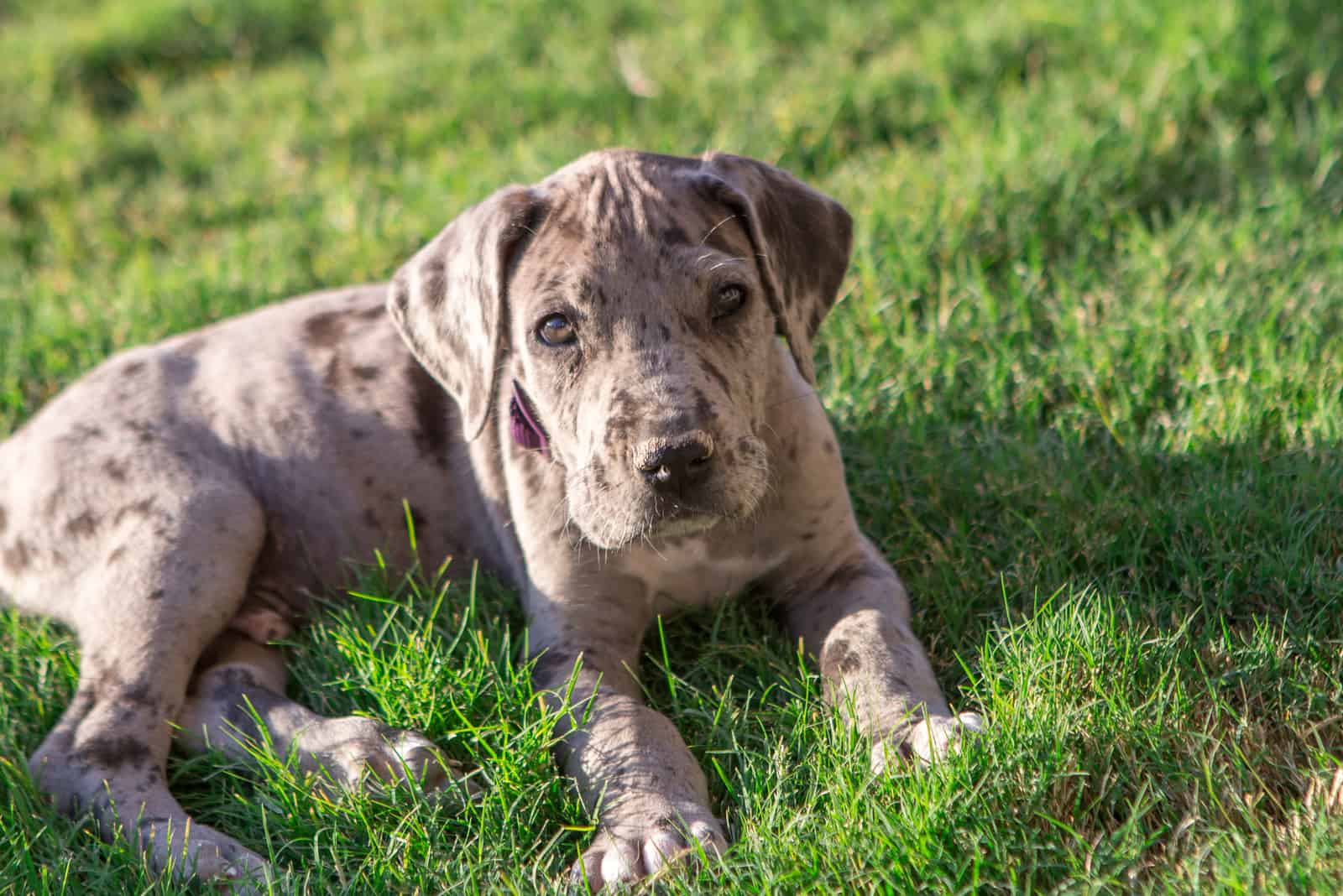
Another difference in American vs. European Great Danes is the puppy’s price. Yes, these two Great Dane breeds can come at a different price!
Of course, every breeder can and will adjust the price to fit its credentials. Still, this is what we’ve found:
European Great Dane
European Great Danes usually come at a price range of $1000 to $2000, although they may be a bit cheaper or more expensive. This depends on the health certification and guarantee, a microchip, kennel club registration, and the shipping price.
American Great Dane
The prices for the American Great Dane puppies tend to vary a bit more compared to the European ones. These dogs usually come at a price of $600 to $3000.
Overall, puppies bred for dog shows cost $1500 to $3000, while puppies intended to be family pets are cheaper, and usually cost $600 to $1500.
Which Great Dane Dog Is Right For You?
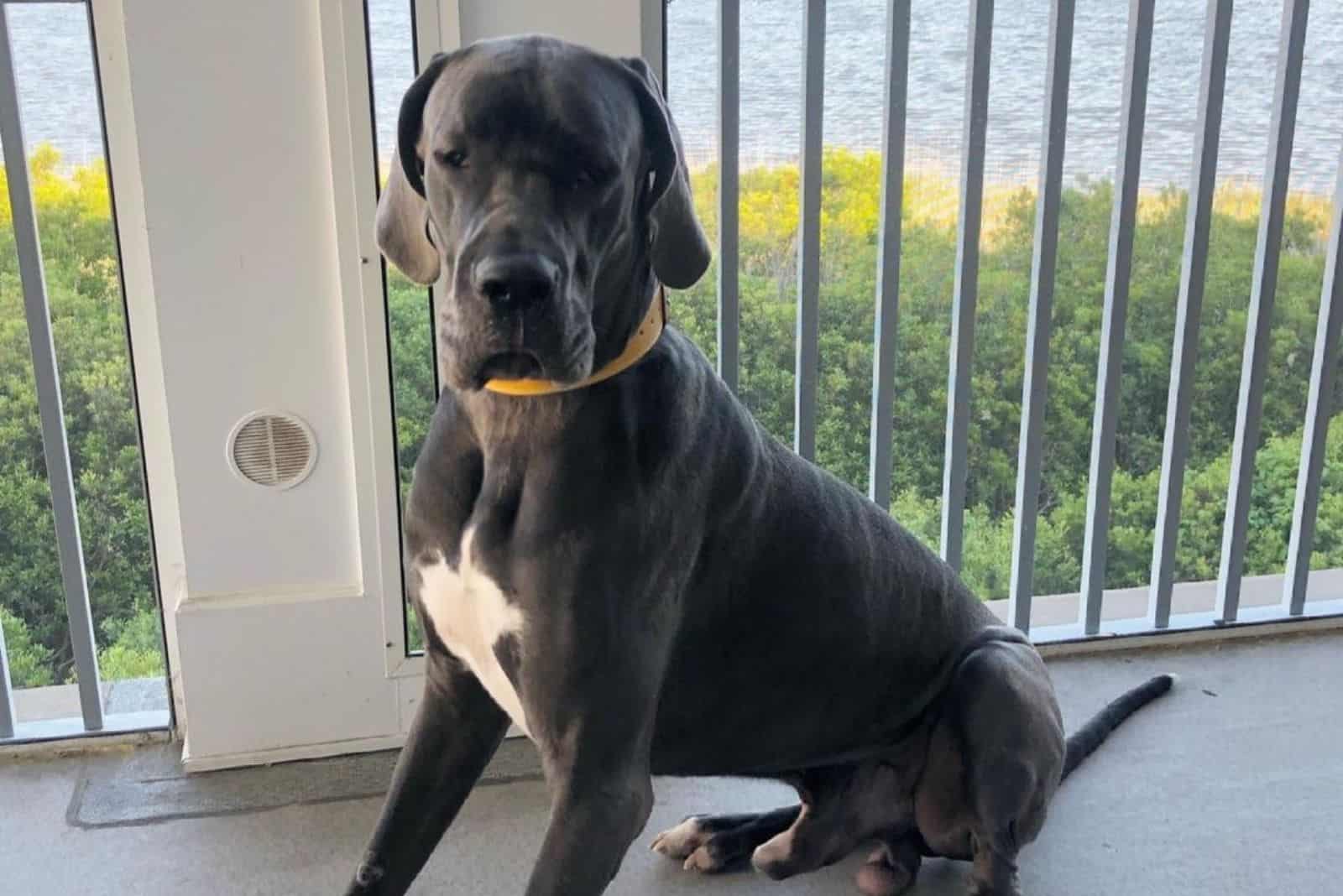
After reading this, you may wonder which one is the better dog for you when it comes to the American vs. European Great Dane. The truth is, both dogs have certain advantages, but they remain quite similar in both behavior and appearance.
Overall, European Great Danes are the perfect choice for people who want a large dog that will keep all the intruders away. These dogs will scare away anyone wanting to trespass onto your property!
They aren’t overly friendly towards strangers, but they are far from aggressive. This means you can get an excellent guard dog without worrying that things would go too far.
Also, they have drooping eyes and loose skin, which is a look that some people prefer. At the same time, they are couch potatoes and they can spend the whole day just napping on your sofa!
Similarly, American Great Danes are also good watchdogs, but with a small difference. While they are very friendly and are unlikely to view anyone as a threat, they are avid barkers, so they’ll always let you know when they see someone – but this can be annoying for some people.
Their friendliness makes them a great choice for people who already have other pets, including other Great Danes. Just keep in mind that you should never keep two American Great Danes of the same sex!
Also, they are suitable for active people who are looking for dogs that can handle long hikes and playtime, and who love being outside.
Finally, they are perfect for people who want elegant-looking, large dogs, but still feel like English Great Danes are a bit too much for them.
Whichever one you choose, there is no mistake – these dogs make amazing family pets, and they’ll stay loyal to you and your family members no matter what.
